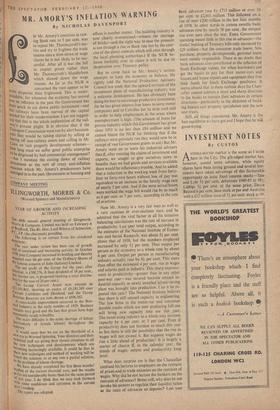INVESTMENT NOTES
By CUSTOS
ASTRIKE-BOUND market is the scene as I write here in the City. The gilt-edged market has, however, scored some advance, while equity shares have been losing ground and several bor- rowers have taken advantage of this favourable opportunity to issue fixed interest stocks—Tate and Lyle 51 per cent. debenture 1980-85 at 984-, Liebigs 54- per cent. at the same price, Decca Record 6 per cent, loan stock at par and Australia with a £12 million issue of 51 per cent, stock at 99. These may be good outlets for investment funds for the short period-especially if some of them open at a discount-but the Treasury is still pur- 8.1-ling its inflation-scare policy of excessive fund- ing-to prevent the long-term rate of interest from falling! The small investor might employ his savings profitably in equity shares which are not speculative favourites and therefore not so vulner- able to market setbacks. I have in mind IMPERIAL loancco, which has declared its profit this week and raised its dividend from 21 per cent. to 223 per cent. At the present price of 75s. 6d. cum dividend, the yield is 6.1 per cent. And what can 80' wrong with British Sugar, to which I called attention on November 27, at 27s. 6d.? The rise in the rate of interest makes it all the more certain that the Government will have to agree to a raising of the dividend rate from 63 per cent. to 73 per cent. The Act allows for a 'reasonable rate of interest' on share capital and reserves (in addition to incentive payments), and last year's earnings Were 32 per cent. At /7s. 6d. to yield 41 per cent. on last dividends and 23 per cent, on earnings, the Shares seem an attractive 'funk hole.'
Two Strong 'Growth' Stocks
Technically a 'growth' stock is simply a share on which the rate of return on an initial invest- ment is expected to rise. But it has come to mean rather more than that-a growth of at least 5 per cent, per annum, in other words, an increase stronger than the national average growth of 3 Percent. per annum. During periods of dull or falling markets the investor would be well advised to pick up shares of this calibre, that is, with relatively high rates of growth. Here are two engineering 'companies with outstanding records. ? he first Is WOODALL-DUCKHAM, Which specialises in the design and manufacture of coke-oven and bY-product recovery plant for the steel, coal and gas industries, with subsidiaries in Australia. Its equity earnings have grown at the rate of 16 per Fent, per annum since 1955 and last year's earn- ings, which will be announced at the beginning of May, will probably beat this high rate of increase. In respect of 1958 the company earned 108 per cent, and paid 25 per cent., and it is Pretty certain that the dividend will be increased, for since 1955 dividends have increased faster than earnings. At the current price of 42s. for the 5s. shares the current dividend yield is just under 3 per cent. and the earnings yield over 12 per cent. Another case is G. N. HADEN, which carries on the business of heatijig ventilating and air conditioning engineers (including special ceilings) with fifteen branches in this country. Its equity earnings have been grow- ing at the rate of no less than 271 per cent, per annum since 1955. In 1958 the company earned (allowitm for the last 75 per cent. bonus) 47 per cent, and paid 144 per cent. The 1959 results will also be published in May and I look tor a further Increase in earnings and dividend. At the present price of 25s. the 5s. shares yield 2.8 per cent, on dividends and 9.4 on earnings. The shares have e.ome back from 29s. 3d. and would be very attrac- tive on any further fall.







































 Previous page
Previous page